I offer this reference guide to Chinese coins with the hope of promoting greater understanding and appreciation these coins but please note THIS IS NOT A LIST OF COINS OFFERED FOR SALE.
Images represent the types and may be larger or smaller than the actual coins.
MEDIEVAL CHINESE COINS
THE NORTHERN SUNG DYNASTY
The Sung Dynasty, established in AD 960, saw relative stability in China, although conflict with the Tartars and Mongols continued. In AD 1127 the northern provinces were lost to them and the capital had to be moved from K'ai-feng Fu (Pien-liang) in the north to Lin-an Fu (Hangchou) in the south. We now refer to the period before the move as the Northern Sung and after the move as Southern Sung.
This is a complex series, with nine Emperors using dozens of reign titles and many inscription and calligraphy variations which defined dates and mints. If all the variations were catalogued, they would number in the thousands. Unfortunately the key to understanding them no longer exists.
If you have not done so, we recommend reading the following comments about the nature of Northern Sung coins. If you are already familiar with this section, you can click here to proceed directly to our listings of the coins.
OUTLINE OF THE BRONZE COINS
At the standard in use since the T'ang, the Northern Sung monetary system was based on full weight bronze 1 cash averaging 3.5 grams, 2 cash averaging 7 grams cast sporadically after AD 1093, and on a few occasions, usually during times of war, bronze 3 and 10 cash fiduciary coins cast to the 2 and 3 cash standard. In addition to bronze coins, fiduciary iron coins were also cast through much of this period.
AD 960 to 1041. The only bronze coins were full-weight 1 cash.
AD 1041. Fiduciary 3 cash (S-505) of about 7 grams and 29 mm. This was the earliest North Sung issue higher than a 1 cash. As a fiduciary issue it proved unpopular and subject to counterfeiting and in AD 1059 was devalued to 2 cash, consistent with the weight.
AD 1070. Fiduciary bronze 10 cash (S-538) of 7.2 grams and 30 mm were issued to raise funds for the Western Wars. As with the earlier fiduciary issues, these were unpopular and subject to counterfeiting and were devalued to 2 cash at the war's end. Iron 10 cash were also issued at this time.
AD 1093. Full-weight 2 cash of about 7.0 grams and 29 mm. (S-575) were introduced as a regular part of the currency, but only issued sporadically.
AD 1102. Fiduciary 10 cash (S-621) were cast in an attempt to introduce them as a regular part of the coinage. At about 11 grams and 31 mm these contained 3 cash worth of metal and were devalued to value 3 cash in AD 1111.
AD 1107. A full weight 10 cash was issued (S-630) at about 27 grams and 50 mm, but was withdrawn within a year. These appear to have been hoarded, and used as a cheap source of metal for counterfeiting the fiduciary 10 cash issues still circulating from the issue of AD 1102.
OUTLINE OF THE IRON COINS
The earliest iron coins consisted of non-fiduciary 1/10 cash. Schjoth (page 28) records: "In the 2nd year of Ching-te (AD 1005) large iron coins were cast in the two localities of Chia-ting Fu and Chiung-chou in Szechuan, value one copper cash or ten small iron cash. These all circulated jointly and gave much satisfaction."
The large iron coins, of bronze 1 cash value, seem to be S-472 (10.83 grams, 35 mm). We believe the "small iron cash" valued at 1/10th of a copper cash are the well known iron issues of bronze cash size and weight which start with the T'ai-p'ing (S-462) issues of AD 976-984. This would explain a passage where Schjoth records Mr. Hu, in AD 978, paid for copying some sacred classics with 120 strings of iron money. Recording payment specifically in iron money would not be necessary unless iron and copper cash were valued differently. This establishes iron at about 1/10th the value of copper, a figure very important to understanding other iron issues. The larger iron coin (S-472), at about 11 grams, was fiduciary with only about 0.3 cash worth of iron.
A careful analysis of the coins, as well as the literary evidence, suggests the following sequence:
AD 978. Non-fiduciary 1/10 cash iron coins are first cast. It is possible that earlier specimens may one day come to light.
AD 990. Non-fiduciary 1/10 cash iron coins cease to be cast, but continue to circulate until at least AD 1005.
AD 1004 (possibly a little earlier). Fiduciary iron 1 cash ware introduced (S-472) at 11 grams, 35 mm and issued sporadically throughout the Northern Sung period but at ever-reducing weights and sizes.
AD 1017. The standard for iron 1 cash is reduced to about 7 grams, 28 mm (S-483).
AD 1023. The size of iron 1 cash is reduced to about 25 mm, but the weight remains at about 7.0 grams (S-487).
AD 1070. Fiduciary iron 10 cash (S-542a) of 35 mm and variable weight between 7.5 and 11 grams are issued to finance the Western Wars. At the end of the war these are devalued to 2 cash.
AD 1093. Iron 2 cash (S-580) introduced at the same standard as the 10 cash of AD 1070, but prove an unsuccessful experiment and by the end of AD 1094 are trading at scrap iron prices (about 0.4 cash).
AD 1101. The weights of iron 1 cash become variable (S-615) averaging about 5.75 grams but specimens between 3.5 and 7 grams are encountered. The size remains consistent at about 25 mm.
AD 1111. Iron 2 cash (29 mm, 7-10 grams) (S-643) and 3 cash (32 mm, 9-11 grams) are cast but again faile to be accepted.
THE NATURE OF THE FIDUCIARY ISSUES
When we were first writing this site, the issuing and later devaluations of fiduciary coins appeared somewhat random, but it quickly became obvious this was not the case.
All of the iron coins, with the exception of the early 1/10 cash issues were fiduciary. Fiduciary 1 cash iron coins were accepted throughout this period, but all attempts at higher denominations were rejected.
It appears that almost all fiduciary bronze coins, and most fiduciary iron over 1 cash, were only cast during times of war or other emergencies and afterwards the bronze coins were devalued to denominations consistent with their size and weight, while iron coins were demonetized and withdrawn from circulation.
Fiduciary bronze was always cast to standards consistent with lower denominations, allowing them to be devalued later and still fit into the pre-existing coinage system. This shows planning, suggesting they were cast with the full intent of a future devaluation. (The same is not true of fiduciary iron coins).
INSCRIPTION VARIETIES
Northern Sung coins present a complex series of inscription variations which, while easily catalogued, are poorly understood. Date and mint codes are probably hidden in these variations, but it is possible we will never understand them.
CALLIGRAPHY STYLES
Schjoth's introduction to Northern Sung coinage (page 27) says: "As regards the style of writing, the coins in the 'seal' writing come first, followed by those in the clerkly or orthodox writing, and ultimately finishing up with the 'running' hand, or 'grass-character' style of writing."
By using "or" he is saying "clerkly" and "orthodox" are one script style, "running hand" and "grass-character" are a second. Seal script is the third style. A quick examination of the coins shows his statement of only three styles of calligraphy are correct.
1) "SEAL" - a very formal style of writing. Rounded characters with a fixed form and all details of each character included. The differences between coins are minor. There is no real Western equivalent, but type set block capital letters come closest.
2) "ORTHODOX" - also referred to as "clerkly". Angular characters with a generally square or rectangular appearance in which most details are made up of distinct either straight or slightly curved stokes. The general layout of a character is fixed, but small details can be left out. From coin to coin there can be significant differences. The closest Western equivalent is handwritten small-case printing.
3) "GRASS" - also referred to as "running hand". Flowing characters on which several details of a character can be represented by a single wavy or jagged line. A form of shorthand in which a character can show major differences from coin to coin. This is distinctly like Western handwriting (as opposed to hand printing).
Confusion throughout the general listings, such as for S-633-637 (page 33) where he states the type exists in both "clerkly" and "orthodox" script leads us to believe Schjoth did not write this part of the catalogue. It must have been written by someone working from his rough notes in which must the terms have been used interchangeably.
We relied on Schjoth's drawings and descriptions to determine the calligraphy style of most issues, but the drawings are not always accurate. Some of the drawings show coins with a mix of orthodox and grass characters, in which cases we list the coin by the style of the 12 o'clock character. If actual specimens confirm this mixing of types, we will comment on them later.
CALLIGRAPHY VARIETIES
From the work of Mr. Berger, we know the Ch'ing Dynasty (AD 1644-1911) used subtle calligraphy variations indicating dates, with two changes per year at each mint. With many mints operating, this produced hundreds of variations for any type issued for more than one or two years. Northern Sung coins also have many variations per issue, suggesting a similar system was already in use, but unlike the Ch'ing coins, for which many official records have survived, and the code has been broken, the Northern Sung code is unlikely to be completely understood (we are told Mr. Berger is trying).
INSCRIPTION ENDINGS
In his introduction to the Northern Sung coinage, Schjoth (page 27) writes: "It will be noted that the Yuan-paos, implying the 'opening' or 'beginning' currency are placed before the T'ung-paos, implying the principle of the 'flowing' currency."
A simple examination of the coins shows no such relationship exists. There is also a third ending,"Chung-pao", which Schjoth has ignored in this passage. We have noted the following pattern in the use of these endings:
AD 960 to 989 - all coins use "T'UNG PAO".
AD 990 to 1007 - all coins use "YUAN-PAO".
AD 1008-1016 - both "T'UNG PAO" and "YUAN-PAO" during the same reign title.
AD 1041 - a third ending of "CHUNG-PAO" was introduced.
AD 1017-1041 - only one ending was used during any reign title, but it could be either "T'UNG PAO", "YUAN-PAO" or (after AD 1041) "CHUNG-PAO.
AD 1053-1126 - no evident pattern. Anywhere from one to three endings used in any reign title. In the cases where only one was used, it could be any of the three.
At this time we cannot comment of the significance of these endings, but there must be one. Coins of some reign titles are very rare and it is possible new types may turn up which will help establish a more significant pattern.
INSCRIPTION ORIENTATIONS
Northern Sung coins occur with inscriptions reading either TOP, BOTTOM, RIGHT, LEFT or TOP, RIGHT, BOTTOM, LEFT. Both orientations occur throughout and some issues can be found either way. We have not yet been able to determine any significance of these two orientations.
MINTING TECHNIQUES AND WEIGHT VARIATIONS
Starting in the late 5th century AD, the majority of Chinese coins were cast in two-piece moist sand molds into which a master coin (called a seed) was used to make many impressions. Channels were cut to connect the impressions and, after joining the two pieces, molten metal was poured in. When taken apart, the mold yielded what looked like a tree studded in coins, which was then cut apart.
The impression of the mold's sand grains leaves a granular surface. The coins were run over a rasp to smooth the surfaces, leaving a series of parallel file marks which wear off very quickly and are only visible on very high grade specimens (a few Ming Rebel issues have courser file marks that do not wear off). The lower points on the coin are not affected by the rasp and usually retain some evidence of the pebbled surface on all but the most worn coins (difficult to see on a heavily patinated coin).
Cutting the coins from the tree left a rough spot on the edges which was then filed smooth. The coins were cast with wide rims to allow for this filing.
This method was easy, very fast and, because all of the coins were impressed with the same seed coin, thousands and even millions of identical coins were possible, allowing calligraphy variations to be used as mint and date control marks. Each coin would be exactly the same diameter except for small size variations caused by filing the edges. The only major drawback was in controlling the weights. It was impossible to control the exact depth of each seed impression, and a slightly deeper impression gave a heavier coin and a shallow one a light coin. Weights could vary as much as 25% from coin to coin, so officials concerned themselves with the average weight of one thousand coins, not the weight of each individual coin, as discussed earlier.
Earlier coins were often cast in handcarved stone (steatite) moulds. No two molds could have identical calligraphy, and controlling the exact depth of the carving was difficult, so coins cast by this method (many of the knife, spade and ban-liang) could vary considerably in weight. The molds had a limited useful life and one could not cast tens of thousands of identical coins. Other early coins were cast in non-reusable clay molds which were produced with a type of seed coin, but the mould-making process was too slow to serve the needs of China's expanding population. The Chinese were aware of lost-wax casting, and used it for many purposes, but the process was far too slow for casting hundreds of millions of coins.
It is difficult to determine the intended denomination of a coin simply by weight. The problem is not too bad with Northern Sung bronze 1 cash which were cast to a standard of 3.5 grams, but could weigh between 2.75 and 4.5 grams. It is worse for 2 cash which at a 7 gram standard vary from 5.5 to 9 grams and overlap with 3 cash at a 10.5 gram standard but vary between 8.25 to 13.5 grams. As can be seen, the heavier 2 cash can weigh more than a light 3 cash. The problem gets worse for higher denominations.
SIZE AND DENOMINATION
These small copper coins did not have a lot of purchasing power and except for the smallest transactions, they were tied together in strings of 100 coins. In this form it was impossible to weight each coin, so how could one be sure a string was not of mixed denominations? The answer is fairly simple. Make each denomination a consistent size and without any special equipment and even a blind man would be able to tell if there were a few small coins in the middle of a string of large coins (or vice versa).
The following chart shows the sizes and average weights known to exist for bronze coins of each reign title (omitting reign titles for which no coins are known). It leaves little doubt that there were distinct size ranges.
| DATE | TITLE | under 23 mm |
23-26 mm |
27-30 mm |
31-35 mm |
over 35 mm |
| 968-975 | KAI-PAO | -- | 3.2 grams | -- | -- | -- |
| 976-984 | T'AI-P'ING | -- | 3.1 grams | -- | -- | -- |
| 990-994 | SHUN-HUA | -- | 3.2 grams | -- | -- | -- |
| 995-998 | CHIH-TAO | -- | 3.5 grams | -- | -- | -- |
| 998-1004 | HSIEN-P'ING | -- | 3.6 grams | -- | -- | -- |
| 1004-1007 | CHING-TE | -- | 3.5 grams | -- | -- | -- |
| 1008-1016 | HSIANG-FU | -- | 3.7 grams | -- | -- | -- |
| 1017-1021 | T'IEN-HSI | -- | 3.2 grams | -- | -- | -- |
| 1023-1031 | T'IEN-SHENG | -- | 3.7 grams | -- | -- | -- |
| 1032-1033 | MING-TAO | -- | 3.9 grams | -- | -- | -- |
| 1034-1037 | CHING-YU | -- | 3.7 grams | -- | -- | -- |
| 1038-1039 | PAO-YUAN | -- | 3.6 grams | -- | -- | -- |
| 1040 | K'ANG-TING | 3.3 grams | -- | -- | -- | -- |
| 1041-1048 | CH'ING-LI | -- | 3.3 grams | 7.2 grams | -- | -- |
| 1049-1053 | HUANG-YU | -- | 2.7 grams | -- | -- | -- |
| 1054-1055 | CHIH-HO | -- | 3.7 grams | -- | -- | -- |
| 1056-1063 | CHIA-YU | -- | 3.5 grams | -- | -- | -- |
| 1064-1067 | CHIH-P'ING | -- | 3.6 grams | -- | -- | -- |
| 1068-1077 | HSI-NING | -- | 3.5 grams | 7.2 grams | -- | -- |
| 1078-1085 | YUAN-FENG | -- | 3.3 grams | 7.0 grams | -- | -- |
| 1086-1093 | YUAN-YU | -- | 3.2 grams | 7.8 grams | -- | -- |
| 1094-1097 | SHAO-SHENG | -- | 3.7 grams | 7.0 grams | -- | -- |
| 1098-1100 | YUAN-FU | 1.7 grams | 3.2 grams | 7.4 grams | -- | -- |
| 1101 | CHIEN-CHUNG | 2.0 grams | 3.6 grams | 6.5 grams | -- | -- |
| 1102-1106 | CH'UNG-NING | -- | 2.7 grams | -- | 10.3 grams | -- |
| 1107-1110 | TA KUAN | -- | 3.85 grams | ?? grams | -- | 23.5 grams |
| 1111-1117 | CHENG-HO | -- | 3.3 grams | 7.2 grams | -- | -- |
| 1118 | CHUNG-HO | -- | 4.9 grams | -- | -- | -- |
| 1119-1125 | HSUAN-HO | -- | 3.4 grams | 6.1 grams | 6.7 grams | -- |
| 1126 | CHING-K'ANG | -- | -- | 7.3 grams | -- | -- |
Included in the average weights are numbers of worn coins which reduce the average weight slightly. In most cases, the original weights were probably about 0.2 grams higher than the average of the surviving coins.
Many of these issues are extremely rare and, for many types, we have been unable to locate actual specimens from which to take weights and measurements. The only readily available source of this information is the Schjoth catalogue, so we have based this table, and our descriptions of the types, on information provided by Schjoth. It is possible, especially for sizes, that some errors are included, but we will modify our listing if actual specimens indicate discrepancies.
COUNTERFEITS
It is important to read our discussion of weights above before proceeding in this section.
TYPE 1
By counterfeit, we refer to illicit castings made at about the same time as the official castings, with the intent of spending them. These can be difficult and in some cases impossible to tell from official castings. Coins made recently, with the intent of fooling collectors, are called forgeries and are generally much easier to spot. No discussion of the forgeries will occur on this site as it would inform the forgers as to what they are doing wrong and allow them to make forgeries that are much more difficult to spot.
Chinese cash were all cast, making the counterfeiter's job very easy, as casting is also the easiest of all counterfeiting methods.
By gathering heavier coins and recasting them as lighter coins, a counterfeiter could turn one hundred coins averaging 4 grams into 145 coins averaging 2.75 grams, a profit of 45%. Assuming an official coin was used as the master, each counterfeit would be at the low end of the acceptable weight range with the correct alloy, size, and calligraphy.
These coins must have been very difficult to spot back then, and almost impossible today. We can safely assume many coins at the lower end of the weight standards are counterfeits, but cannot be sure which ones. Official and counterfeit coins freely circulated side by side at the time, so both are part of China's numismatic history and we therefore see little reason to worry about them.
TYPE 2
Many coins, including some listed by Schjoth, are much smaller and generally lighter than the normal standard. It is likely that most of these are illicit castings. There are some documented cases of very crude, small, light coins with Northern Sung (and other) types being cast for local use in parts of Southeast Asia. They were never meant to fool anyone in China and in some cases were cast hundreds of years after the official castings. They are an interesting collecting area unto themselves.
Emperor CHAO K'UANG YIN
AD 960-976
Chao K'uang Yin, chief General of the Posterior Zhou Dynasty disposed of Emperor Shih Tsung in AD 959, declaring himself Emperor and casting Posterior Zhou coins with the "ZHOU-YUAN T'UNG-PAO" inscription. Within one year he established the Northern Sung Dynasty, adopting the T'ai Tsu reign title.
Reign title: T'AI TSU, AD 960-968
Schjoth (page 27) lists "T'ai Tsu" as the Emperor's name and not a reign title. We cannot identify any coins of this period, but the "SUNG-YUAN T'UNG-PAO" issues attributed to the following reign title may have first been cast at this time, as one would expect these to have been Chao K'uang Yin's first issue.
Reign title: KAI-PAO, AD 968-975
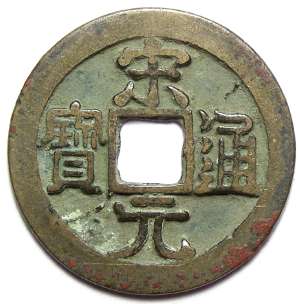 S-451 Orthodox Script |
Kai-pao is Chao K'uang Yin's second reign title, but does not appear on his coins as it was considered incorrect for the character for "Pao" to occur twice on the same coin. Rather, "SUNG-YUAN T'UNG-PAO" (referring to the coinage of Sung) was used.
S-451. Bronze 1 cash. Obverse: "SUNG-YUAN T'UNG-PAO" in orthodox script. Reverse: blank. Average (10 specimens) 25.2 mm, 3.40 grams.
VG $2.50 F $4.00We recently notice some specimens of this type that were only about 23.0 mm and around 2.40 grams (not included in the average above) while this type is nearly always over 25 mm and greater than 3 grams (we have seen one that was 25.7 mm, 4.20 grams). At this point we are not certain what the status of these smaller coins is, but suspect they are either contemporary counterfeits, or possibly Japanese or Annamese imitative coins.
S-452-8. Bronze 1 cash. Obverse: "SUNG-YUAN T'UNG-PAO" in orthodox script. Reverse: any of various nail marks, dots and vertical strokes, but there are more types than Schjoth lists. Average (4 specimens) 25.0 mm. Average 4.71 grams.
VG $5.00 F $7.50 VF $11.50I have noted three types of reverse marks that appear on this type, dot (or star), crescent (or nail mark), and a stright stroke or bar which can be horizontal or vertical, each of which can appears in various position of which I have so far noted:
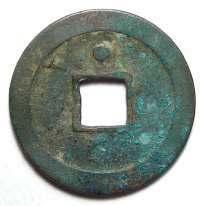 | dot/star seen at top left |
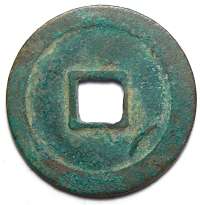 | crescent/nail mark seen at top upper right upper left left lower right bottom |
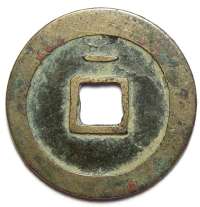 | bar/stroke top right (vertical) left (vertical) bottom |
Other position should exist
S-459. Iron 1/10 cash (see above). Obverse: "SUNG-YUAN T'UNG-PAO" in orthodox script. Reverse: blank. 24 mm. Schjoth's specimen weighed 4.09 grams. We have not seen one of these and cannot assign a value at this time.
These are reported to have been cast in Szechuan, Shansi or Fukien. Ding Fubao (Fisher' s Ding) suggest these might be mother cash (models used to cast the seed cash), but average rim width makes that impossible.
Emperor T'AI TSUNG
AD 976-997
Reign title: T'AI-P'ING, AD 976-984
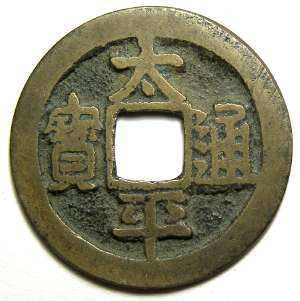 S-460 Orthodox Script |
S-460. Bronze 1 cash. Obverse: "T'AI-P'ING T'UNG-PAO" in orthodox script (meaning "Money of the Heavenly Kingdom"). Reverse: blank. Average (4 specimens) 24.8 mm, 3.21 grams.
F $2.50 VF $4.00S-461. Bronze 1 cash. Obverse: "T'AI-P'ING T'UNG-PAO" in orthodox script. Reverse: crescent at top. 24 mm. Schjoth's specimen weighed 3.1 grams We have not had one, and cannot provide a value at this time (this does not necessarily mean it is rare).
S-462. Iron 1/10 cash. Obverse: "T'AI-P'ING T'UNG-PAO" in orthodox script. Reverse: blank. 24 mm. Schjoth's specimen weighed 4.16 grams. These are rare and we have no record of a value for the issue.
(The 1/10 cash denomination is based on information discussed above.)
It is recorded that a proposal was put forward to cast larger iron coins for this reign title. We assume the larger 1 cash similar to those of the "CHING-TE" reign title were intended, but we find no evidence they were cast.
Reign title: ??, AD 985-989
Schjoth, Fisher's Ding and Mitchiner record no information about this period, but clearly show a gap between the preceding and following reign title. We will have to look further into this in the future.
Reign title: SHUN-HUA, AD 990-994
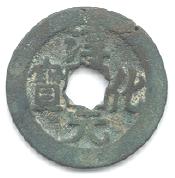 S-463 Orthodox Script | 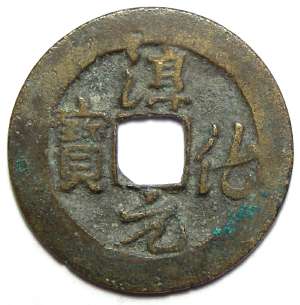 S-464 Running hand Script |
S-463-464. Bronze 1 cash. Obverse: "SHUN-HUA YUAN-PAO" in orthodox and running hand script. Schjoth says there is a grass script type by we have not seen one, and neither Schjoth nor Hartill lists one. Reverse: blank. We have noted specimens with star holes. Average (4 specimens) 24.4 mm, 3.3 grams.
F $2.50 VF $4.00Reign title : CHIH-TAO, AD 995-998
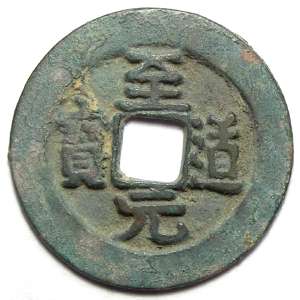 S-465 Orthodox script |
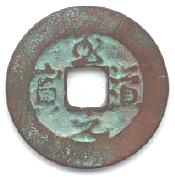 S-467 Mixed scripts |
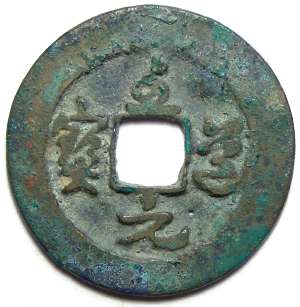 S-468 Grass Script |
S-465-468. Bronze 1 cash. Obverse: "CHIH-TAO YUAN-PAO" in orthodox, grass script and one type of mixed scrip (top and bottom in grass script, left and right in orthodox script). Reverse: blank. 24.6 mm. Average (12 specimens) 3.58 grams (excluding a 2.2 gram specimen must have been a contemporary counterfeit).
F $2.50 VF $4.00Emperor CHEN TSUNG
AD 998-1022
Reign title : HSIEN-P'ING, AD 998-1004
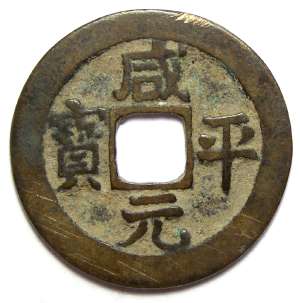 S-470 Orthodox Script Broad rims |
S-469-470. Bronze 1 cash. Obverse: "HSIEN-P'ING YUAN-PAO" in orthodox script. Reverse: blank. There is only one caligraphy style for this issue, but it comes with both narrow (S-469) and wide (s-470) rims. Average (6 specimens) 24.5 mm, 3.54 grams.
F $2.50 VF $4.00Reign title: CHING-TE, AD 1004-1007
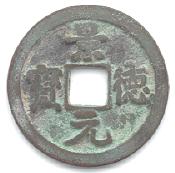 |
S-471. Bronze cash. Obverse: "CHING-TE YUAN-PAO" in orthodox script. Reverse: blank. Average (9 specimens) 24.6 mm. 3.78 grams
VG $1.75 F $2.50 VF $4.00Schjoth (page 28) records 1,830,000 strings of this issue were cast in each of the four years of this reign title. Each string was 100 coins, indicating about 732 million coins cast.
S-472. Iron 1 cash. Obverse: "CHING-TE YUAN-PAO" in orthodox script. Reverse: blank. 35 mm. Schjoth's specimen weighed 10.83 grams. Rare, no value can yet be assigned.
In spite of the weight, it is fairly certain these were issued as 1 cash (see our discussion of iron coins). He records (page 28) these were cast in the second year of Ching-te (AD 1005) at Chia-ting Fu and Chiung-chou in Szechuan.
Reign title: HSIANG-FU, AD 1008-1016
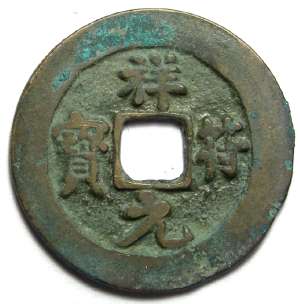 S-474 Orthodox script Yuan-Pao ending | 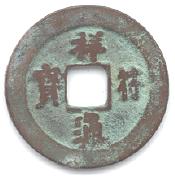 S-477 Orthodox script T'ung Pao ending |
With "T'UNG PAO" and "YUAN-PAO", this is the first occurrence of multiple inscription endings during a reign title (See our discussion of inscription varieties).
S-473-474. Bronze 1 cash. Obverse: "HSIANG-FU YUAN-PAO" in orthodox script (large and small calligraphy). Reverse: blank. Average (5 specimens) 24.9 mm. 3.94 grams.
VG $1.75 F $2.50 VF $4.00S-475. Bronze 1 cash. Obverse: "HSIANG-FU YUAN-PAO" in orthodox script. Reverse: blank. Schjoth's specimen was 26.0 mm. 5.58 grams. This coin has very wide rims, is 1.2 mm larger than usual, and is considerably above the 1 cash standard weight range. It has all the characteristics one would expect from a SEED CASH and as such should be considered a very rare specimen, however the size is in line with 2 examples of S-477 we describe below, and in fact this may turn out to be fairly common. More research needs to be done on this issue, and we cannot currently assign a value to it.
S-478. Iron 1 cash. Obverse: "HSIANG-FU YUAN-PAO" in orthodox script. Reverse: blank. 34 mm. Schjoth's specimen weighed 10.82 grams (about the same as S-472). This is a rare coin and we cannot provide a valuation.
S-476-477. Bronze 1 cash. Obverse: "HSIANG-FU T'UNG-PAO" in orthodox script (large and small calligraphy) Reverse: blank. Average (2 specimens) 25.7 mm, 4.55 grams (Schjoth shows his specimens as about 24 mm. Average 3.8 grams, however the 2 specimens we recently examined averaged 25.7 mm, 4.55 grams, suggesting Schjoth's listing may have been in error).
VG $1.75 F $2.50 VF $4.00Reign title: T'IEN-HSI, AD 1017-1021
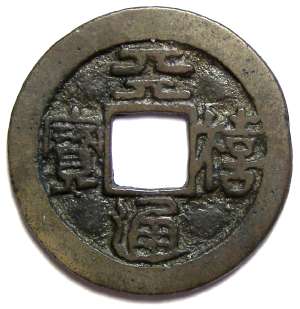 S-479 Four different scripts | 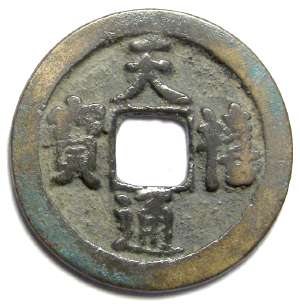 S-480 Orthodox Script |
Schjoth (page 29) records that during the last year (AD 1021) at least four mints were casting copper coins (Yung-ping at Jao-chou in Kiangsi, Yung-feng at Ch'ih-chou in Anhui, Kuang-ning in Fookien, and Feng-huo at Chien-chou in Shansi) and a few other mints may have operated briefly at Pien-liang (the capital) and Hangchow. Three mints cast iron coins (Chiung-chou, Chia-ting-fu and Hsing-chou, all in Szechuan) and in one year 1.5 million strings were cast, but it is not clear if this includes the iron issues.
He also records a formula for the bronze alloy: in 5 cattie of coins was 3 cattie 10 ounces of copper, 1 cattie 8 ounces of lead and 8 ounces of tin.
S-479. Not in Hartill or FD, so a scarce type. Bronze 1 cash. Obverse: "T'IEN-HSI T'UNG-PAO" in four different scripts. Reverse: blank. Average (1 specimens) 23.8 mm, 2.79 grams.
F $25.00 VF $45.00Schjoth states that this type has a different calligraphy styles on each of the four characters: "T'IEN" - seal script, "HSI" - orthodox script, "T'UNG" - grass script, "PAO" in li (official) script, and while this is not clear from his drawings, the specimens we have now seen bare this out. This is the earliest occurrence of seal script on a Northern Sung coin, possibly an experimental coin to see how it would look. However, this is controversy over this type, as while Schjoth believed it to be a Chinese issue (hence we include it here) there are others that think it is an Annamese issue, but there appears to be no clear consensus on this.
S-480,482. Bronze 1 cash. Obverse: "T'IEN-HSI T'UNG-PAO" in orthodox script. Reverse: blank. Average (2 specimens) 24.5 mm, Schjoth had two specimens, one of 24 mm. 4.16 grams. Schjoth has a specimen that was only 21 mm, 2.48 grams, which is likely a counterfeit of the period and which has be left out of our average size and weight figure.
VG $1.75 F $2.50 VF $4.00S-481. Bronze 1 cash. Obverse: "T'IEN-HSI T'UNG-PAO" in orthodox script. Reverse: crescent at top left. 24 mm. 3.15 grams. We have not had this type and cannot provide a valuation at this time.
S-483. Iron 1 cash. Obverse: "T'IEN-HSI T'UNG-PAO" in orthodox script. Reverse: blank. 28 mm. Schjoth's specimen weighed 7.52 grams. This is a very rare coin and we cannot provide a valuation at this time.
This is smaller and lighter than the iron coins cast during the previous two reign titles, but slightly heavier than those of the next. Please see our general discussion of the iron coins for why we believe they are 1 cash and not 2 cash as Schjoth suggests.
Reign title: CH'IEN-HSING, AD 1022
No coins seem to have been cast for this reign title.
Emperor JEN TSUNG
AD 1023-1063
Jen Tsung used nine reign titles, casting coins for all of them. He used as many as ten denominations of mixed iron and bronze, with numerous variations in script style and orientation, providing dozens of major and hundreds of minor varieties.
Reign title: T'IEN-SHENG, AD 1023-1031
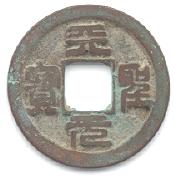 S-484 Seal Script | 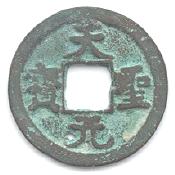 S-486 Orthodox |
S-484-486. Bronze 1 cash. Obverse: "T'IEN-SHENG YUAN-PAO" in seal and orthodox scripts. Reverse: blank. Average (12 specimens) 24.8 mm 4.11 grams.
VG $1.75 F $2.50 VF $4.00S-487-488. Iron 1 cash. Obverse: "T'IEN-SHENG YUAN-PAO" in seal and orthodox scripts. Reverse: blank. Schjoth had two specimens of 25 mm and averaging 6.6 grams, smaller and lighter than those cast in the previous reign title. This type is rare and we have not been able to establish a value for it.
Reign title: MING-TAO, AD 1032-1032
| IMAGE NOT YET AVAILABLE S-489 seal script | IMAGE NOT YET AVAILABLE S-490 orthodox script |
S-489-490. Bronze 1 cash. Obverse: "MING-TAO YUAN-PAO" in seal and orthodox scripts. Reverse: blank. 25 mm. Schjoth had two specimens averaging 4.0 grams. The orthodox script variety is common but we are not certain about the rarity of the seal script type.
VG $1.75 F $2.50 VF $4.00S-491. Bronze 1 cash. Obverse: "MING-TAO YUAN-PAO" in orthodox script. 25 mm. Reverse: nail mark in top left corner. Schjoth had one specimen of 3.55 grams. We have not yet determined a value for this variety.
Schjoth does not record any iron coins for this reign title.
Reign title: CHING-YU, AD 1034-1037
| IMAGE NOT YET AVAILABLE S-402 seal script | IMAGE NOT YET AVAILABLE S-494 orthodox script |
S-492-494. Bronze 1 cash. Obverse: "CHING-YU YUAN-PAO" in seal and orthodox script. Reverse: blank. 25 mm. Average 3.73 grams.
VG $1.75 F $2.50 VF $5.00S-495. Iron 1 cash. Obverse: "CHING-YU YUAN-PAO" in orthodox script. Reverse: blank. 25 mm. 6.8 grams. We have not handled one of these and cannot provide a valuation for it.
Schjoth records: "Hsu Chia's proposal to cast coins by a chemical process, of fusing copper and iron, was adopted.". We assume this refers to a copper-iron alloy but have not been able to determine which coins these were. As copper was worth more than iron, it makes little sense to issue iron coins with a copper content, but a considerable saving could be had by adding some iron to mostly copper issues. Some years ago we had a few North Sung cash that looked like rusty iron, but were non-magnetic, which we assumed just had a peculiar patination. However, they were issued under the reign title HSUAN-HO around AD 1119-1125 which is 100 years after this (An image of one is available via this link).
Reign title: PAO-YUAN, AD 1038-1039
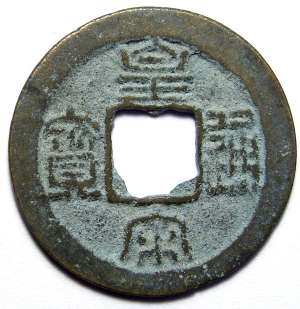 S-498 Seal Script | 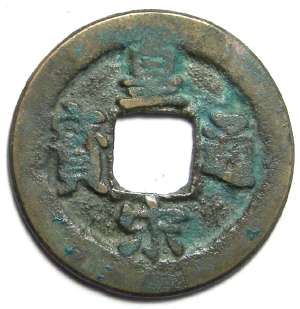 S-500 Orthodox Script |
"Huang-Sung" was used instead of "Pao-Yuan" on these coins. To do otherwise would have repeated the character "Pao", a practice considered to be incorrect.
S-496-500. Bronze 1 cash. Obverse: "HUANG-SUNG T'UNG-PAO" (Imperial currency of Sung) in seal and orthodox script. Reverse: blank but one example with a star shaped hole. Average (2 specimens) 24.5 mm. 3.35 grams.
VG $1.75 F $2.50 VF $4.00S-501-502. Iron 1 cash. Obverse: "HUANG-SUNG T'UNG-PAO" (Imperial currency of Sung) in seal and orthodox script. Schjoth had two specimens, one of 24 mm, 7.53 grams and the other of 25 mm, 7.07 grams. These are rare and we cannot provide a valuation at this time.
Reign title: K'ANG-TING, AD 1040
| IMAGE NOT YET AVAILABLE S-503 orthodox script |
Jen Tsung only used this reign title for less than a year and very few coins were issued. We have never seen one.
S-503. Bronze 1 cash. Obverse: "K'ANG-TING YUAN-PAO" in orthodox script. Reverse: blank. 18 mm. 3.35 grams. This specimen is far too small for an official casting, but the weight is too high to suggest a contemporary counterfeit. As this is very rare and does not fit with then normal structure of the coinage, it may be a modern forgery. We note Fisher's Ding (Ding Fubao) lists two Iron 1 cash for this reign title, but no bronze coins.
Schjoth (page 29) records: "In the K'ang-ting year, the official, Pi Chung-yuan, drawing attention to the bad state of the finances and the requirements for frontier expenditure, proposed the issue of a large currency, 'value ten' of copper and iron." We have found no evidence that value ten cash were cast during this or either of the next two reign titles, but this passage is important as it shows that iron and copper coins could be cast and be circulating at identical denominations.
Reign title: CH'ING-LI, AD 1041-1048
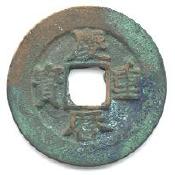 S-504 read from top, then around to the right | 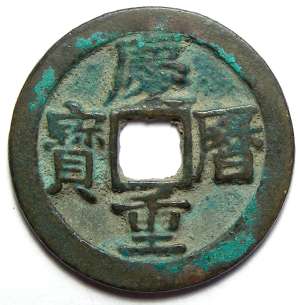 S-505 read top-bottom-right-left |
S-506. Bronze 1 cash. Obverse: "CH'ING-LI CHUNG-PAO" in orthodox script reading top-bottom right left. Reverse: blank. 24 mm. 3.35 grams. We have not recorded a value for this type.
S-504 and 505. Bronze, 3 cash. Obverse: "CH'ING-LI CHUNG-PAO" in orthodox script with orientations reading top-bottom right-left (504) and top around to the right (505). Reverse: blank. Average (10 specimens) 7.4 grams with a range from 6.2 to 8.6 grams, 30-31 mm (the 8.6 gram specimen was 32 mm).
F $15.00 VF $25.00These weights are correct for value 2 cash, but Schjoth (page 30) records: "In the 4th year of Chia-yu (AD 1059), owing to the increased casting by the people of illicit coins, the 'value three' coins of the heavy issue of Ching-li chung-paos were reduced to the value of two cash".. This clearly suggests the heavier "Ch'ing-li" coins were issued as a fiduciary three cash, making them subject to counterfeiting.
Reign title: HUANG-YU, AD 1049-1053
| IMAGE NOT YET AVAILABLE S-507 orthodox script |
S-507-508. Bronze 1 cash. Obverse: "HUANG-YU YUAN-PAO" in orthodox script. 23 mm. Schjoth had two specimens weighing 2.15 and 3.2 grams. This issue is rare and we have no record of a price for it.
It appears from Schjoth (page 30) that during this reign title an order was given to cast value 10 large copper and iron coins, but there is no evidence that these coins were actually cast.
Reign title: CHIH-HO, AD 1054-1055
| IMAGE NOT YET AVAILABLE S-509 Seal Script with YUAN-PAO | 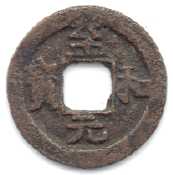 S-511 Orthodox Script with YUAN-PAO |
| IMAGE NOT YET AVAILABLE S-512 seal script | IMAGE NOT YET AVAILABLE S-513 orthodox script |
S-509-511. Bronze 1 cash. Obverse: "CHIH-HO YUAN-PAO" in seal and orthodox scripts. Reverse: blank. 24 mm. Average 3.72 grams.
VG $1.75 F $2.50 VF $4.00S-512-513. Bronze 1 cash. Obverse: "CHIH-HO T'UNG-PAO" in seal and orthodox script. Reverse: blank. 24 mm. Average 3.62 grams. We have no valuation records for this type.
Reign title: CHIA-YU, AD 1056-1063
| IMAGE NOT YET AVAILABLE S-514 Seal Script | 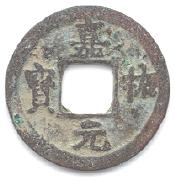 S-515 Orthodox Script |
S-514-515. Bronze 1 cash. Obverse: "CHIA-YU YUAN-PAO" in seal and orthodox script. Reverse: blank. We have noted an orthodox script example with a star shaped hole. 24 mm. Average 3.87 grams.
VG $1.75 F $2.50 VF $4.00S-516-518. Bronze 1 cash. Obverse: "CHIA-YU T'UNG-PAO" in seal and orthodox script. Reverse: blank. Schjoth notes an orthodox script example with a star shaped hole. 24 mm. Average 3.32 grams.
VG 1.75 F $2.50 VF $4.00Emperor YING TSUNG
AD 1064-1067
Reign title: CHIH-P'ING, AD 1064-1067
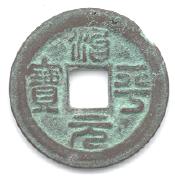 S-519 seal script | 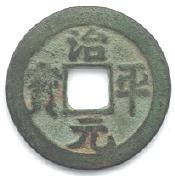 S-522 orthodox script |
S-519-523. Bronze 1 cash. Obverse: "CHIH-P'ING YUAN-PAO" in seal and orthodox scripts. Reverse: blank. 24 mm. Average 3.34 grams.
VG 1.75 F $2.50 VF $4.00This type often exists with an unusual style of "CHIH". Munro believes these were cast in Japan, which is possible. We will elaborate on this at some future date.
| IMAGE NOT YET AVAILABLE S-524 seal script | IMAGE NOT YET AVAILABLE S-526 orthodox script |
S-524-526. Bronze 1 cash. Obverse: "CHIH-P'ING T'UNG-PAO" in seal and orthodox script. Reverse: blank. 24 mm. Average 3.97 grams. Our records do not include a price for this type, but it is probably the same as those above.
Schjoth (page 30) records that during this reign title, 1,700,000 strings of cash (100 coins per string) were cast annually from six minting departments.
Emperor SHEN TSUNG
AD 1068-1085
Schjoth (page 31) records that as many as twenty-six mints operated during this period, with a combined annual mintage as high as five-and a half million strings.
Reign title: HSI-NING, AD 1068-1077
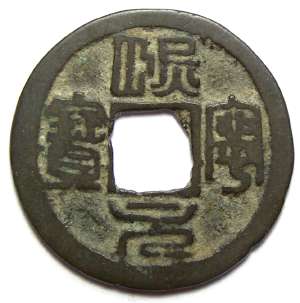 S-527 seal script version 1 with Yuan-pao | 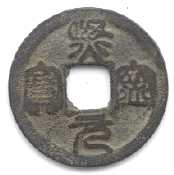 S-529 seal script version 2 with Yuan-Pao. | 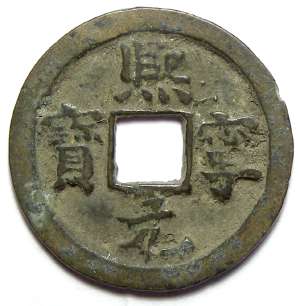 S-535 orthodox script one of several styles with Yuan-Pao |
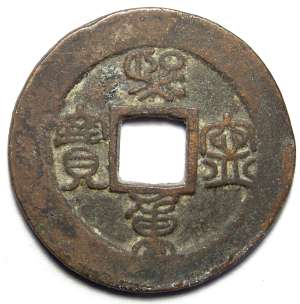 S-538 seal script with Shung-pao | 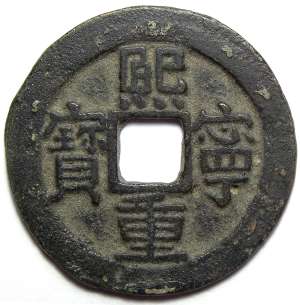 S-537 orthodox script style 1 with Chung-pao | 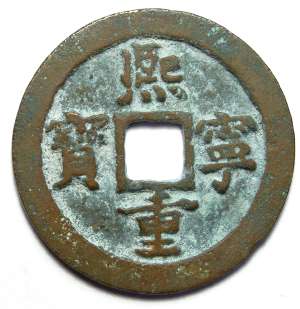 S-542 orthodox script style 2 with Chung-pao |
All coins of this reign title read from the top around to the right. Early in the reign only 1 cash coins were cast, and those with orthodox script tend to be style 1. Later in the reign the large denominations were cast, on which those with orthodox script tend to be style 2. It is not yet clear to me is the 1 cash denomination continued to be made after the larger denominations were introduced.
EARLY ISSUES
S-527-530 and 532-535. Bronze 1 cash. Obverse: "HSI-NING YUAN-PAO" in seal (two different versions) and orthodox scripts (3 different versions). Reverse: blank. Average (2 specimens) 23.8 mm. Average 3.12 grams. One with a star-shaped hole has been noted.
VG $1.75 F $2.50 VF $4.00One of Schjoth's specimens weighed only 1.63 grams. It is probably a contemporary counterfeit and in not included is the average weight calculation.
S-531. Bronze 1 cash. Obverse: "HSI-NING YUAN-PAO" in orthodox script. Reverse: crescent at bottom. 24 mm. Schjoth's specimen weighed 3.7 grams. We have not recorded a value for this type.
S-544. Iron 1 cash. Obverse: "HSI-NING YUAN-PAO" (or "T'UNG-PAO") in orthodox script. Schjoth's specimen must have been in poor condition as the exact reading was uncertain). Reverse: blank. 25 mm. Schjoth's specimen weighed 7.53 grams. We cannot provide a valuation for this type at this time.
At 7.53 grams and 25 mm, this appears to be a 1 cash and must have been part of this early series.
S-536-537. Bronze 1 cash. Obverse: "HSI-NING CHUNG-PAO" in seal and orthodox scripts. Reverse: blank. 25 mm. Average 3.57 grams. Our records do not currently include a value for this type.
Schjoth describes these as larger than usual, but 25 mm is not enough larger to be significant.
LATER ISSUES
Schjoth (page 31) records the following passage: "During the years the armies moved westward, coins value ten were cast. When the war was ended and the armies withdrawn, the illicit casting of coins set in, and the value of the large coinage had to be reduced to 'three' and eventually to 'two'. On the recommendation of some high officials, henceforward, of the larger issues of coins only value two were cast and these circulated throughout the empire."
S-538-42a. Bronze 10 cash. Obverse: "HSI-NING CHUNG-PAO" in seal and orthodox script. Reverse: blank. The size of these varies between 30 and 32 mm, with significant weight variations between about 6.5 and 8.5 grams. Based on 43 specimens we found an average weight of about 7.8 grams. These fit a 2 cash standard but appear to have been issued at 10 cash, later devalued to 2 cash. We have noted one example with a star-shaped hole.
VG $2.50 F $4.00 VF $7.50, gVF $9.00From a recent hoard we noticed that the type S-538 seems to come in both the 30 to 32 mm size (later re-valued to 3 cash) and in the 28 to 29 mm size (later re-valued to 2 cash). It is possible that the 28-29 mm specimens were a distinctly different issued from the 30-32 mm specimens.
S-543. Iron 10 cash. Obverse: "HSI-NING T'UNG-PAO" in orthodox script. 35 mm. Schjoth's specimen weighed 10.54 grams. These are rare and we have not seen one, and cannot provide a valuation for it.
The passage about war-issue 10 cash coins (see above) does not mention iron coins, but at 35 mm these are large coins and are likely of this series as they do not fit anywhere else.
Reign title: YUAN-FENG, AD 1078-1085
| IMAGE NOT YET AVAILABLE S-546 orthodox script | 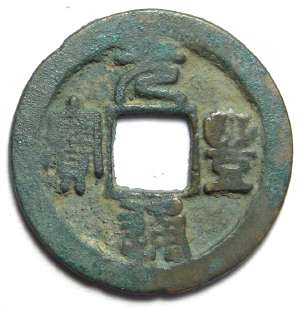 S-545 seal script | 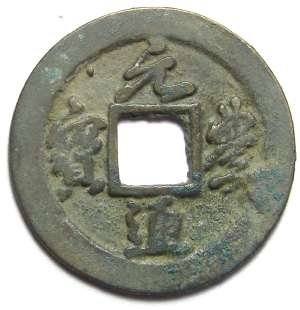 S-556 grass script |
1 CASH ISSUES
S-545-550. Bronze 1 cash. Obverse: "YUAN-FENG T'UNG-PAO" in seal, orthodox and grass scripts. Reverse: blank or with crescent. We have also seen one example with a star hole (add about 60% to the price for a crescent or star hole). Average (36 specimens) 24.5 mm, 3.90 grams. We have noted that there is a range of sizes with specimens noted from 23.5 to 25.1 mm.
VG $1.75 F $2.75 VF $5.00S-551-552. Bronze larger 1 cash. Obverse: "YUAN-FENG T'UNG-PAO" in seal and grass scripts. Reverse: blank. Average (3 specimens) 25.6 mm, 3.56 grams (range 2.87 to 4.15 grams). These are interesting coins, and the consistently large size suggest they are a separate issue from those above, but the weights are well within the 1 cash weight range. At this point, we do not know why the two issues exist, but we do not that coins of this size were cast during earlier reign titles (see S-477 above).
VG $7.50 F $9.75 VF $12.50S-563-564. Iron 1 cash. Obverse: "YUAN-FENG T'UNG-PAO" in seal and grass scripts. Reverse: blank. Schjoth had two specimens of 25 and 24 mm. Average 7.05 grams. The same weight and size as the iron 1 cash cast prior to the war and appear to be a re-introduction of that denomination at the end of the war. We have not seen an example of these and cannot provide any valuation for them at this time.
LARGE ISSUES
S-553, 556. Bronze 10 (2) cash. Obverse: "YUAN-FENG T'UNG-PAO" in seal and grass script. Reverse: blank. These vary between about 28 and 31 mm (average is 30 mm), and based on 31 specimens we found an average weight of 7.44 grams. We have also seen some examples with a star hole which should be worth a small premium).
VG $2.50 F $4.00 VF $6.00S-554, 555, 557-559. Bronze 10 (2) cash. Obverse: "YUAN-FENG T'UNG-PAO" in seal and grass script. Reverse: several varieties with an assortment of dots and crescents. 28 mm. Schjoth had 5 specimens averaging 6.45 grams. We do not have any records of valuations for these variations, but they should be worth some premium over the plain-reverse examples above.
S-560-562. Iron 10 cash. Obverse: "YUAN-FENG T'UNG-PAO" in seal and grass scripts. Reverse blank or with a nail mark. 30 mm. Averaging 11.88 grams, these are of the same standard as the fiduciary 10 cash issues cast during the previous reign title. We have not handled any of these and cannot provide a valuation at this time.
The Western Wars were ongoing during the early years of this reign title, so these heavy coins were probably a continuation of the fiduciary 10 cash of the previous reign title which were devalued at first to 3 and then to 2 cash.
Schjoth records (page 31): "In the 8th year of Yuan-yu '(AD 1086)', when Che Tsung ascended the throne, fourteen of the old mints were closed. During the eight years that followed Shansi had orders to re-issue its small currency."
It appears Shansi issued larger coins until AD 1086. We have not found the year in which the Western War ended, but it appears to have been before AD 1086 indicating some of these heavy coins were cast at a 2 cash denomination (we believe this probably only applies to the bronze issues). As the bronze 10 cash were cast to the two cash standard, it is probably not possible to differentiate early 10 cash from later 2 cash.
Emperor CHE TSUNG
AD 1086-1100
Reign title: YUAN-YU, AD 1086-1093
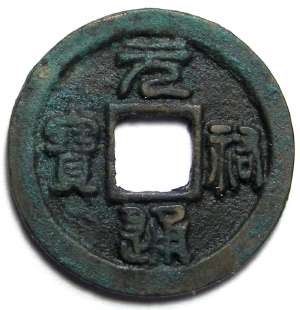 S-565 seal script | 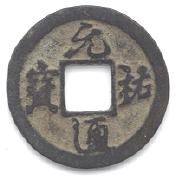 S-567 grass script |
S-565-8. Bronze 1 cash. Obverse: "YUAN-YU T'UNG-PAO" in seal and grass scripts. Reverse: blank. 24.5 mm. Average about 3.85 grams (17 specimens).
VG $1.75 F $2.50 VF $4.00S-569-572. Bronze 1 cash. Obverse: "YUAN-YU T'UNG-PAO" in seal script. There are unusual North Sung issues with the following reverses: S-569 - numeral 1, S-570 - numeral 2, S-571 - "Ch'uan" (a stream) and- S-572 - characters meaning "ten months". 24 mm. Average 2.96 grams. These are rare. We have never seen one and cannot provide a valuation for them.
These coins do not fit with the rest of the North Sung series. Schjoth's suggestion that these may have been cast is Japan could be correct. There is no indigenous coinage from Japan during the Northern Sung period and it appears Japan used Chinese coins during this period, so it is likely some North Sung types were cast in Japan.
S-573-574. Metal ?? value ??. Obverse: "YUAN-YU T'UNG-PAO" in seal and grass scripts. Reverse: blank. 24 mm. Schjoth lists these as bronze 1 cash, but the weights of 6.06 and 5.52 grams fit into the weight/size standard for iron 1 cash. Until we are able to confirm the alloy and weights of these two coins, we do not wish to classify them. We would appreciate hearing from anyone with access to the Schjoth collection (we think it is in Oslo, Norway) who can check them for us.
S-577-578. Iron 1 cash. Obverse: "YUAN-YU T'UNG-PAO" in seal and grass scripts. 24 mm. Averaging about 7.12 grams. The weight and size are at the iron 1 cash standard suggesting these are early issues of this reign title. Schjoth does not mention orthodox script for this type, but his illustration of S-578 shows "YUAN" in orthodox script. We have not handled any of these and cannot currently provide a valuation for them.
ISSUES OF AD 1093
Schjoth (page 31) records value two cash were re-introduced in AD 1093, but discontinued in favor of 1 cash after two years. This title ends in the first year, so some must have been cast under the following reign title. Schjoth indicates all two cash were discontinued, but numismatic evidence indicates only iron 2 cash were discontinued while bronze two cash continued to be cast.
S-575-576. Bronze 2 cash. Obverse: "YUAN-YU T'UNG-PAO" in seal and grass scripts. Reverse: blank. 29 mm. Average 7.85 grams (the weight standard previously established for bronze 2 cash). We note these usually show up in gF or better.
F $3.50 VF $5.50S-580-581. Iron 2 cash. Obverse: "YUAN-YU T'UNG-PAO" in seal and grass scripts. 34 mm. Average 11.03 grams (the standard used during the previous two reign titles for 10 cash later reduced to 2 cash).
F $25.00 VF $37.50These are the earliest Northern Sung iron coins we have seen available in recent years. It is very possible they came from a single hoard and may turn out to be scarcer than the values we have seen would indicate.
Reign title: SHAO-SHENG, AD 1094-1097
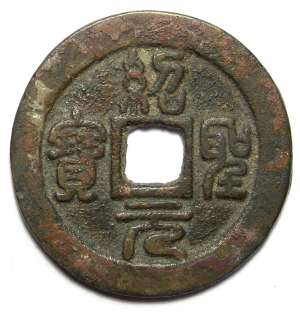 S-582 seal script with Yuan Pao | 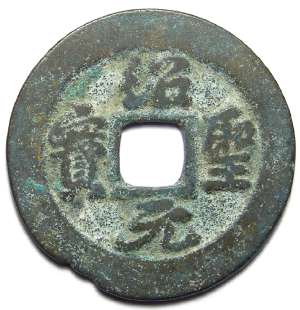 S-586 grass script with Yuan-Pao | IMAGE NOT YET AVAILABLE S-592 orthodox script with T'ung-Pao |
ISSUES OF AD 1094
S-597-598. Iron 2 cash. Obverse: "SHAO-SHENG T'UNG-PAO" in seal and grass scripts. Reverse: blank. 34 mm. Average 11.0 grams (the size and weight standard of the iron 2 cash issued in AD 1093). These must be part of the series discontinued after AD 1094.
F $25.00 VF $42.50Schjoth records that the "Book of Economical Economy of Sung" (v. Hui-k'ao, vol iv p. 24a) states: "During the first years of the Shao-sheng style, the copper coins were daily becoming more scarce, while the iron ones were increasing numerous, a thousand copper-cash were received in exchange of two thousand five hundred of iron."
This is an interesting passage. It appears bronze coins were being issued at their metal value of about 3.5 grams per cash (see below), but the 11-12 gram iron 2 cash had been demonetized (or people refused to accept them) and were trading at their scrap iron value. Two and a half iron 2 cash, between 27.5 and 30 grams of iron, were exchangeable for a 3.5 gram copper 1 cash (an 8 or 9 to 1 ratio). This supports our earlier belief that iron was worth about 10% of copper and that this had changed little by the late Northern Sung period.
The government's response was to withdraw the iron 2 cash coins, although it appears that iron 1 cash were still cast and accepted. We find no evidence of iron 2 cash being cast again during the balance of the Northern Sung period, but some brief but unsuccessful attempts at other denominations did occur.
OTHER ISSUES OF AD 1094 AND LATER
S-582, 585, 586, 591. Bronze 1 cash. Obverse: "SHAO-SHENG YUAN-PAO" in seal and grass scripts. Reverse blank. Average (4 specimens) 24.5 mm, average 3.90 grams (excluding S-585 which at only 21 mm and 1.82 grams is probably a contemporary counterfeit).
F $2.50 VF $4.50583-584, 587-590. Bronze 1 cash. Obverse: "SHAO-SHENG YUAN-PAO" in seal and grass scripts. Reverse: a variety of crescents and dots. Average (6 specimens) 24.5 mm, 3.87 grams. We have no records of values for these, but they should be worth some premium over the blank-reverse type.
S-596. Iron 1 cash. Obverse: "SHAO-SHENG YUAN-PAO" in grass script. 24 mm. Reverse: blank. Schjoth's specimen weighed 7.02 grams. We have no records of value for this type at this time.
S-593-595. Bronze 2 cash. Obverse: "SHAO-SHENG YUAN-PAO" in seal and grass script. Reverse: blank. Average (3 specimens) 29.3 mm, 6.85 grams.
F $3.50 VF $5.50S-592. Bronze 1 cash. Obverse: "SHAO-SHENG T'UNG-PAO" in orthodox script. Reverse blank. 24 mm. Schjoth's specimen weighed 2.94 grams. We have no record of handling this type.
Reign title: YUAN-FU, AD 1098-1100
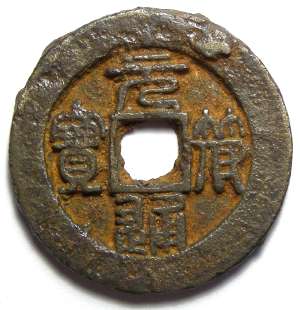 S-606 >seal script variety with T'ung-Pao | IMAGE NOT YET AVAILABLE S-602 grass script with T'ung-Pao |
S-599, 602. Bronze 1 cash. Obverse: "YUAN-FU T'UNG-PAO" in seal and grass scripts. Reverse: blank. 23 mm. Average about 3.21 grams.
F $2.50 VF $4.50S-600-601. Bronze 1 cash. Obverse: "YUAN-FU YUAN-PAO" in seal script. Reverse: crescents in various positions. 23 mm. Average about 3.41 grams. We have no record of handling these.
S-603. Bronze 1 cash. Obverse: "YUAN-FU T'UNG-PAO" in grass script. Reverse: blank. At 21 mm and 1.66 grams this is probably a counterfeit.
S-606. Iron 1 cash. Obverse: "YUAN-FU T'UNG-PAO" in seal script. Reverse: blank. 29 mm. Schjoth's specimen weighed 5.86 grams. We do not have a valuation for this type.
S-604-605. Bronze 2 cash. Obverse: "YUAN-FU T'UNG-PAO" in seal and grass scripts. Reverse: blank. 28 mm. Average 7.40 grams.
VG $2.50 F $3.50 VF $6.50H-16.336 (Schjoth does not list this denomination). Iron 3 cash. Obverse: "YUAN-FU T'UNG-PAO" in seal script. Reverse: blank. Average (1 specimen) 34.2 mm, 13.23 grams.
F $30.00 VF $45.00Emperor HUI TSUNG
AD 1101-1125
Hui Tsung's coinage is very complex with several attempted reforms, including the introduction of some new fiduciary issues. We have done our best to sort these out, but in some cases only speculations can be offered.
Reign title: CHIEN-CHUNG CHING-KUO, AD 1101
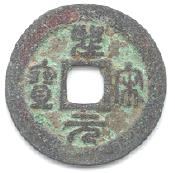 S-607 seal script | 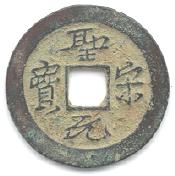 S-609 grass script |
An unusual reign title, composed of four rather than two characters, which does not fit the normal coin layout. "SHENG-SUNG" was used instead.
S-607, 609. Bronze 1 cash. Obverse: "SHENG-SUNG YUAN-PAO" in seal and grass scripts. Reverse: blank. Average (3 specimens) 24 mm. Average 3.65 grams.
VG $1.75 F $2.50 VF $4.00S-608, 610. Bronze 1 cash. Obverse "SHENG-SUNG YUAN-PAO" in seal and grass scripts. Reverse: blank. S-608 at 19 mm, 1.92 grams and S-610 at 21 mm, 2.16 grams. The size and weights suggest Schjoth's specimens were contemporary counterfeits, but the types do exist at regular size and weight.
S-611. Bronze 1 cash. Obverse: "SHENG-SUNG YUAN-PAO" in grass script. Reverse: crescent. 24 mm. Schjoth's specimen weighed 3.28 grams. We have not handled one of these and cannot currently suggest a value.
S-612-614. Bronze 2 cash. Obverse: "SHENG-SUNG YUAN-PAO" in seal and grass scripts. Reverse: blank. 28 mm. Average 6.53 grams.
VG $2.50 F $3.50 VF $5.50The iron coins of this reign title are a little perplexing. This is one of the areas where we can only offer speculations, and more study is needed.
S-615-617. Iron 1 cash. Obverse: "SHENG-SUNG YUAN-PAO" in seal and grass scripts. Reverse: blank. The sizes and weights of Schjoth's specimens are very inconsistent. One of 23 mm, 3.91 grams, one of 25 mm, 5.67 grams and one of 21 mm, 2.72 grams.
VG $55.00 F $70.00 VF $100.00During the balance of the Northern Sung, 23 to 24 mm iron coins were sporadically cast at both a 5 to 6 and 3 to 4 gram standard. It is important to remember iron coins are fiduciary, even at the heavier standard containing about 0.2 cash worth of metal. It has been our observation that size is more significant than weight in determining denomination, and that both of these standards are intended to be value 1 cash. We believe the 21 mm specimen above may have been a counterfeit of the period.
S-618. Iron coin of uncertain denomination. Obverse: "SHENG-SUNG YUAN-PAO" in orthodox script. Reverse: blank. At 33 mm and 12.59 grams this coin is larger and heavier than the iron 2 cash issued earlier, but the same as the earlier iron 10 cash that were later demonetized. This appears to be an attempt to introduce a large fiduciary iron coinage, but we have found no evidence to suggest the intended denomination, although the size is the same as the bronze 10 cash of the next reign title. Rare, we have no valuation currently available.
Reign title: CH'UNG-NING, AD 1102-1106
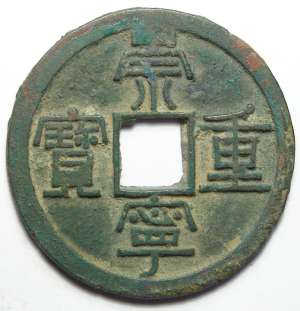 S-620 Orthodox Script CH'UNG-NING CHUNG-PAO read top-bottom-right-left | 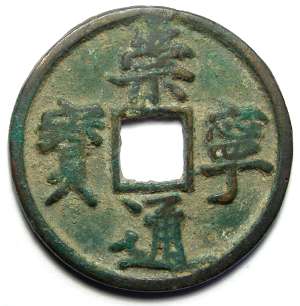 S-621 Orthodox Script CH'UNG-NING T'UNG-PAO read top-right-bottom-left | IMAGE NOT YET AVAILABLE S-626 Orthodox Script CH'UNG-NING YUAN-PAO read top-right-bottom-left |
While the coins with the Chung-Pao ending, and those with the T'ung-Pao ending, appear to have very different caligraphy styles, they are both variations of Othodox Script.
Schjoth lists value 1, 5 and 10 cash for this series, but his literary reference mentions only 10 cash. We have so far found no convincing evidence of any coins cast with the intent of a 5 cash denomination.
REGULAR SERIES
S-626. Iron 1 cash. Obverse: "CH'UNG-NING YUAN-PAO" in orthodox script. 25 mm. 6.04 grams. We have not seen an example of these and cannot provide a valuation at this time.
Schjoth does not list any bronze coins with the "YUAN-PAO" inscription, but the existence of this iron coin proves the inscription was used. It is likely that bronze issues exist but are very rare.
S-619, bronze 1 cash, "CH'UNG-NING T'UNG-PAO". Orthodox script. 25 mm. 3.27 grams. This is consistent with a 1 cash denomination. The 1 cash is rare with this inscription.
VF $90.00S-625, iron 1 cash, "CH'UNG-NING T'UNG-PAO". Orthodox script. 24 mm. At 3.46 grams, this is consistent with the iron 1 cash denomination (S-615) issued under the previous reign title. We have not seen one of these and cannot provide a value.
S-620, bronze 1 cash, "CH'UNG-NING CHUNG-PAO". Orthodox script. 25 mm. At 2.12 grams it is unlikely that this is an official issue, but it may be a contemporary counterfeit of a value 1 cash coin of this type. We cannot provide a value for this type at this time.
FIDUCIARY 10 CASH SERIES
Schjoth records (page 32): "In the 1st year of Ch'ung-ning (AD 1102) the Board of Revenue directed that the four minting departments of Chiang, Yao, Shih and Chien should hand in samples of the new currency ...... Each string of a thousand of the value-ten coins weighed 14 catties 7 liang, 9 catties 7 liang 2 mace being copper, 4 catties 12 liang 6 mace being lead, 1 catty 9 liang 2 mace being tin, the waste by melting being 1 catty 5 liang. Each coin weighed 3 mace."
As far as we have been able to determine 3 mace is about 11 grams, so this passage must be referring to an issue of larger bronze coins. We also note that the two halves may not belong together. The first is about testing 1000 coins that already exist. In the second part "waste by melting" suggests the formula is the amount of metal needed to cast 1000 coins, including the casting sprew that is left after the coins are removed from the trees. This is still open to interpretation.
Schjoth (page 33) also records: "In the 1st year of Cheng-ho (AD 1111), orders were issued that 'value ten' coins, which grasping officials for momentary gain some years before had issued to the harm of the government and the people, should be reduced to 'value three'. The Minister Chang Shang-ying (died 1121) obtained leave to demonetize all the spurious 'value 10' coins met with and cast them into light weight Hsiao-p'ing cash".
Bronze 3 cash should weigh about 10.5 grams, but this passage also makes it clear that 10 cash coins were being cast to a 3 cash standard. It is also clear that counterfeits were abundant. We believe the large coins of this period are the coins referred to, and that any under 8 grams are probably examples of the counterfeits.
S-621. Bronze 10 cash (Schjoth calls it a 5 cash). Obverse: "CH'UNG-NING T'UNG-PAO" in orthodox script. Reverse: blank. Average (8 specimens) 34.1 mm, 11.47 grams (at the 3 cash standard). These are generally well cast coins with bold characters and fairly high rims.
F $8.00 VF $15.00 XF $22.50S-624 is a double-obverse example of the S-621 issue (31 mm, 12.38 grams). Double-obverse coins were never a tradition in China and it is unlikely to be an authentic issue. There are other double-sided fantasy coins that are believed to have been cast during the 19th century for the collector's market.
S-622, 623. Bronze 10 cash. Obverse: "CH'UNG-NING CHUNG-PAO" in orthodox script. Reverse: blank. Average (7 specimens) 9.65 grams, with the range between 7.6 and 13.3 grams. The range from 34 to 36 mm. Two of the specimens were under 8 grams were poorly cast and probably old counterfeits, leaving an average of 10.5 grams for the remaining specimens. These are generally bold, well cast coins.
F $10.00 VF $15.00Schjoth (page 32) records a story of the enemy melting iron coins to manufacture iron weapons, so tin and lead were added to the alloy to make the metal soft and brittle, not suitable for weapons. The iron coins of this series may be those referred to. "Enemies making weapons" shows these fiduciary coins were cast in a time of war, just as similar coins were cast during the Western Wars 35 years earlier.
S-627. Iron 10 (?) cash. Obverse: "CH'UNG-NING T'UNG-PAO" in orthodox script. Reverse: blank. 32 mm. Schjoth's specimen weighed 10.07 grams. This is in the same weight and size standard as the bronze 10 cash issue, suggesting this was intended to circulate at that denomination. Rare.
Reign title : TA KUAN, AD 1107-1110
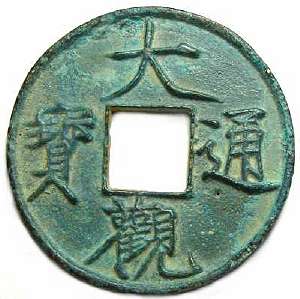 S-630 Orthodox Script |
"TA-KUAN YUAN-PAO" in orthodox script, with very fine calligraphy said to be in the Emperor's own hand, which Hartill refers to as "slender gold" script. They come in a number of different denominations, in both bronze and iron, all with blank reverses. In later times this was a popular model for amulets with a wide variety of reverse types, which are are not coins.
Bronze 1 cash, 23 to 24 mm, average 3.85 grams. S-628-629.
F $2.50 VF $4.00Bronze 2 cash, 29 mm. FD-1059, Hartill 16.421.
F $60.00 VF $85.00Bronze 10 cash, average (5 specimens) 41.0 mm, 17.5 grams. S-630.
VF $25.00 XF $45.00This is a large and impressive type first cast in AD 1107, which is reported to have been withdrawn in AD 1109 due to excessive counterfeiting, although we expect that report is a little muddled. When these were issued at about 17 grams, the 11 to 12 gram value 10 coins of the previous reign title were still circulating and counterfeiters could make a significant profit melting these and using the bronze to cast the earlier type. The recall was probably to stop this counterfeiting of that earlier type. These are far too common for a coin officially withdrawn after only two years, suggesting they were hoarded in large numbers at the time.
Schjoth's specimen weighs 23.52 grams and 40 mm, equivalent to value 8 cash, but it was double-sided and probably an amulet made much later (probably Ming or even Ching period).
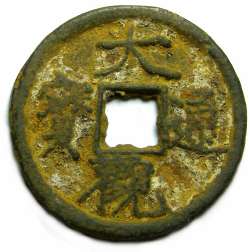 S-632 - iron Orthodox Script |
Iron 1 cash. Schjoth's specimen was about 23 mm, 3.42 grams. S-631.
F $40.00 VF $75.00Iron 10 cash (what Hartill calls a 2 cash). Average (2 specimens) 30.5 mm. 7.35 grams. S-632. The size and weight are within the standard for fiduciary 10 cash of the previous reign and since those 10 cash were not devalued to 3 cash until after these coins were issued, we believe these were also issued as feduciary 10 cash.
F $30.00 VF $55.00Reign title: CHENG-HO, AD 1111-1117
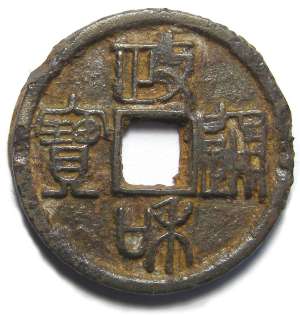 S-645 Seal Script | 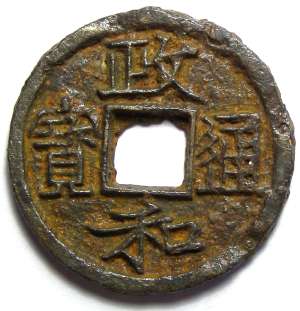 S-646 Orthodox Script |
S-633-636. Bronze 1 cash. Obverse: "CHENG-HO T'UNG-PAO" in seal and orthodox scripts. Reverse: blank. 24 mm. Average 3.37 grams.
F $2.50 VF $4.00 XF $7.00S-637. Bronze 1 cash. Obverse: "CHENG-HO T'UNG-PAO" in orthodox scripts. Reverse: crescent. 24 mm. Schjoth's specimen weighed 3.11 grams. We currently have no record of a value for this type.
S-638-640. Bronze 2 cash. Obverse: "CHENG-HO T'UNG-PAO" in seal and orthodox scripts. Reverse blank. Average (4 specimens) 29 mm, 6.89 grams.
F $3.50 VF $5.50S-641-642. Iron 1 cash. Obverse: "CHENG-HO T'UNG-PAO" in seal and orthodox script. Reverse: blank. Schjoth has two specimens, one of 25 mm, 6.51 grams and another of 21 mm, 5.56 grams (possibly a counterfeit).
F $25.00 VF $45.00No bronze 3 cash were cast during this reign title, but Schjoth (page 33) records information suggesting many bronze value 3 cash must have been in circulation: "In the 1st year of Cheng-ho (AD 1111), orders were issued that 'value ten' coins, which grasping officials for momentary gain some years before had issued to the harm of the government and the people, should be reduced to 'value three'. The Minister Chang Shang-ying (died 1121) obtained leave to demonetize all the spurious 'value 10' coins met with and cast them into light weight Hsiao-p'ing cash".
This passage cannot be referring to the type S-630 as these contained at least 8 cash worth of copper and had been recalled in AD 1109. The 10 cash of the western wars had been devalued long before, so the reference must be to the value 10 coins of the Ch'ung-ning reign title which contain about 3 cash worth of metal.
"Hsiao-p'ing cash" is a term that can describe any lightweight cash. In some other references it appears to refer to value 1 cash of either bronze or iron, but in a few references seems to specifically mean fiduciary iron coins where "lightweight" means coins which weigh far less than the value at which they circulated, in which case they may be the following two coins:
S-643-644. Iron 2 cash. Obverse: "CHENG-HO T'UNG-PAO" in seal and orthodox scripts. Reverse blank. 29 mm. Schjoth had two specimens, 6.82 and 9.66 grams. The size and weight of these suggests a value 2 denomination was intended.
F $25.00 VF $45.00S-645-646. Iron 3 cash. Obverse: "CHENG-HO T'UNG-PAO" in seal and orthodox scripts. Reverse blank. Average (2 specimens) 31.8 mm, 32 mm. Average 9.10 grams. The size and weight of these suggests a value 3 denomination was intended.
F $25.00 VF $45.00Reign title: CHUNG-HO, AD 1118
| IMAGE NOT YET AVAILABLE S-647Orthodox Script |
S-647. Bronze 1 (?) cash. Obverse: "CHUNG-HO T'UNG-PAO" in orthodox script. Reverse: blank. 26 mm. 4.97 grams. This coin is peculiar in not fitting into any of the regular size and weight standards. If truly a medieval coin, it would probably be a counterfeit value 2 cash, and being a rare type, we would prefer to examine it for authenticity before committing to a classification for it.
Reign title: HSUAN-HO, AD 1119-1125
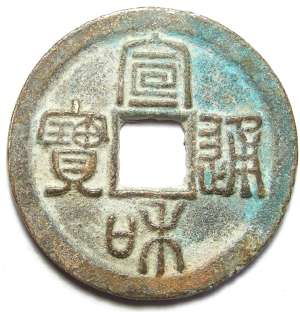 S-656 Seal Script with T'UNG PAO | 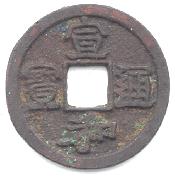 S-660 Orthodox Script with T'UNG PAO | IMAGE NOT YET AVAILABLE S-652 Orthodox Script with YUAN PAO |
S-648-650 & 653-655. Bronze 1 cash. Obverse: "HSUAN-HO T'UNG-PAO" in seal and orthodox scripts. Reverse: blank. 24 mm. Average 3.51 grams.
F $3.50 VF $6.00S-651. Bronze 1 cash. Obverse: "HSUAN-HO T'UNG-PAO" in seal script. Reverse: crescent at the top and star (more like a donut) at the bottom. 24 mm. 3.05 grams. We have not had this type, and cannot suggest a value at this time.
S-662. Bronze 1 cash. Obverse: "HSUAN-HO T'UNG-PAO". Orthodox (?) script. Reverse: "SHEN". 24 mm. Schjoth's specimen weighed 3.0 grams. These are rare and we cannot currently assign a value to them.
We assume "SHEN" is a mint mark (very unusual on a Northern Sung coin). Schjoth lists this as a bronze pattern for the iron coin of the same type (see below), but at this time we have no reason to believe this to be true.
S-666. Iron 1 cash. Obverse: "HSUAN-HO T'UNG-PAO" in orthodox (?) script. Reverse: "SHEN" (see above). 24 mm. Schjoth's specimen weighed 3.58 grams. These are rare and we cannot currently assign a value to them.
S-663-665. Iron 1 cash. Obverse: "HSUAN-HO T'UNG-PAO" in seal and orthodox scripts. Reverse: blank. Schjoth' had two of 23 mm averaging 5.85 grams, and one of 21 mm, 4.16 grams. These appear to be of and iron 1 cash but the 21 mm specimen may be a counterfeit. These are rare and we cannot currently assign a value to them.
S-656-657. Bronze 2 cash. Obverse: "HSUAN-HO T'UNG-PAO" in seal and orthodox scripts. Reverse: blank. Average (4 specimens) 28.1 mm. Average 6.28 grams. These are common, and must have been a huge issue as these are very common.
F $3.50 VF $5.50S-658-661. Bronze 2 or 3 cash. Obverse: "HSUAN-HO T'UNG-PAO" in seal and orthodox script. Reverse: blank or with a crescent. Average (five specimens) 30 mm, 6.6.84 grams. The crescent reverse should be worth a premium. These are common, and must have been a huge mintage.
F $3.50 VF $5.50These larger "HSUAN-HO T'UNG-PAO" coins are a bit of a mystery. The two distinct sizes of 28 and 30 mm suggests two denominations, but both specimens weigh in the 2 cash standard. We need to examine more specimens, and study the coins that follow in the Southern Sung, before commenting further on this series.
S-652. Bronze 1 cash. Obverse: "HSUAN-HO YUAN-PAO" in orthodox script. Reverse: blank. 24 mm. Schjoth's specimen weighed 3.24 grams, which he notes had an alloyed appearance, but we are not certain what he meant by that. We have no record of a value for this type.
Emperor CH'IN TSUNG, AD 1126
Reign title: CHING-K'ANG, AD 1126
| IMAGE NOT YET AVAILABLE S-667 seal script | IMAGE NOT YET AVAILABLE S-670 orthodox script |
Coins of this reign title are all rare although we have had a few over the years. Unfortunately we do not have a record of the prices. We are attempting to track down the purchasers in order to retrieve this information and image the coins.
S-669-670. Iron 1 cash. Obverse: "CHING-K'ANG T'UNG-PAO" in seal and orthodox script. Reverse: blank. Schjoth had two specimens, one of 21 mm, 5.7 grams and the other of 24 mm, 7.13 grams. These fall into the weight standard for late North Sung iron 1 cash, but the 21 mm specimen is too small and may be a counterfeit. Rare, no valuation available.
S-667-668. Bronze 2 cash. Obverse: "CHING-K'ANG T'UNG-PAO" in orthodox script. Reverse: blank. 30 mm. Average 7.25 grams. Rare, no valuation available.
Schjoth mentions the existence of varieties not represented in his collections, including some with the "CHING-K'ANG YUAN-PAO" inscription, as well as specimens with orthodox script.
The dynasty name was changed to Southern Sung after the northern provinces were lost to the Mongol invaders in AD 1127. For a discussion of the Southern Sung coinage please continue to the next page.
Southern Sung Dynasty
Copyright © 1997 - 2025 R & T Enterprises Ltd.